Is my receiver cast or forged?
Is my receiver cast or forged?
| There are many differences that can easily be seen between the 2 types of receivers. Lest start with the magazine well. On all AR15/M16 style lowers, the magazine wells are beveled, or "ramped" to allow for a more expedient and reliable magazine change. The forged lowers start out life as a solid piece of aluminum. The cast lowers are a hollow casting from step one. These 2 photos show a comparison between the machined mag well bevel of a forged lower, and the "cast-in" or more rounded bevel of the cast receiver. | |
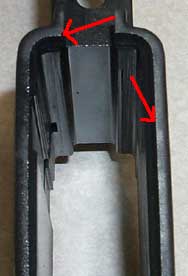 Arrows highlight edges. This is a forged lower. On the moth of the mag well you can see a "machined bevel". A clear line is evident where the tooling actually cut the bevel in the mag well. | 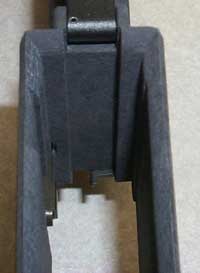 Notice beveled edges. On this cast receiver, you can see that the magazine well bevel is much more rounded, and does not have any tooling marks, as there is no cutting done to the casting to create the bevel, as on the forged lower to the left. |
Here we will show the differences in the area surrounding the magazine release button, often referred to as the "fence". This fence was not on the original M16 lower receiver, but was added in later versions to help prevent the accidental release of the magazine, a potentially deadly situation in combat. | |
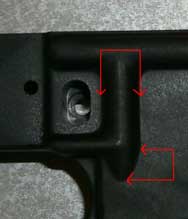 Notice the wider fence. On this, the forged receiver, you can see 2 main differences. Above, the red arrows show the width of the mag well fence vertically. Below, you will see how the vertical fence line slowly tapers making a sort of point. | 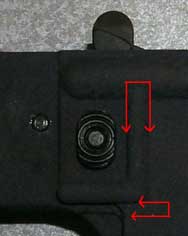 No fence and no taper. Here on the cast receiver, the vertical fence is no tic ably thinner (more narrow), and the vertical fence line simply ends at the corner creating NO pointed taper. |
In this comparison we are looking at the magazine well fence; the ridge around the magazine well. This ridge is important structurally, in that it provides the thinner walls of the magazine well with some added rigidity, and leaves more material for the machining of the mag well bevel. | |
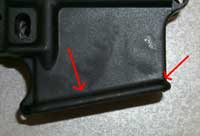 Notice the smooth fence taper. Here the forged receiver shows a mag well fence that smoothly tapers into the mag well body. | 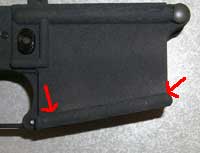 Mag well fence is a rounded lip. On the cast receiver, the mag well fence looks basically like a half-moon ridge that was stuck on the mouth of the mag well. It does NOT have the smooth transition from ridge to mag well body. |
Now we get to the 2 main noticeable differences. This set of photos shows a comparison of the selector switch stops on the left side of the receivers. | |
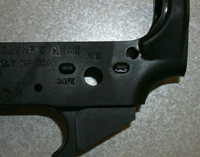 Selector stops present. Here it is clearly seen that the forged lower receiver has selector stops marked "safe" and "fire". | 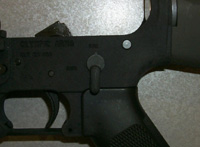 Cast has no selector stops. Here, on the cast receiver, those stops are noticeably missing. |
Finally, the real kicker, the inside of the magazine well. The pictures show the difference between the cast and forged mag wells. If you are to turn the lowers upside down, and point them away from you, you'd be looking at what we'd call the "leading edge" of the inside of the magazine well. There is a big and noticeable difference between the cast and forged receivers here. | |
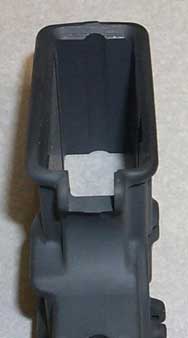 Mag well has a groove on the front. On the forged receiver there is a small crescent shaped groove that is machined into the from inside of the magazine well. | 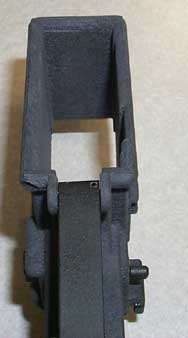 Cast has no groove on the mag well. In the cast receiver, there is not groove. This difference is true of all of our cast and forged receivers. |
In closing here is some serial number information on cast receivers. We have made cast receivers on separate occasions, and these receivers have had distinctive serial number prefixes. When we first produced cast receivers in the 1993-1994 era, those cast receivers had a serial number prefix of "CA", which obviously stood for "cast". Our current production cast receivers have a serial number prefix of "SGW" which stands for our old trade name of "Schuetzen Gun Works".
What this means is that all cast receivers have either one of those prefixes, BUT all CA and SGW serial numbers may not be cast receivers. I know, I know, this really puts some mud in the soup, but let me explain.
Therefore, you could have an SGW or CA serial number and still have a forged receiver. That is why we have this page in our web site!
